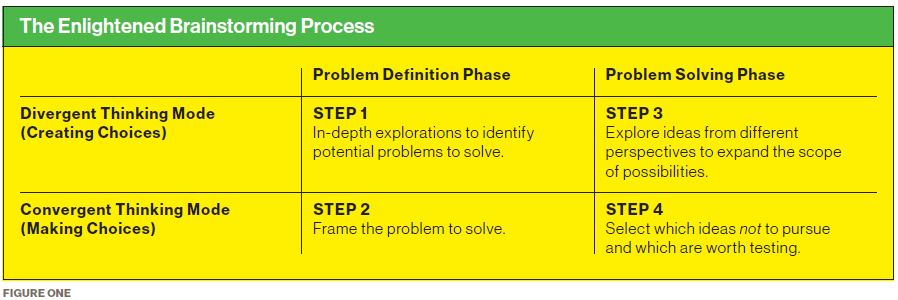In the realm of creativity research, there are two schools of thought: the ‘tension’ view and the ‘foundational’ view. Please describe them.
Most people are familiar with the ‘tension view’ — which is commonly referred to as ‘diversity of thought’ or ‘recombination of ideas’. The underlying concept is that new ideas are in tension with how we currently think. We get so embedded in one way of thinking about the world, that it is very difficult to break out of it. Within this view of creativity, if you want new ideas, you should bring diverse people from different backgrounds, brainstorm, and do some form of recombining of their ideas to get to a breakthrough.
The second view of creativity is known as the ‘foundational view’, and it suggests that, in fact, creativity isn’t so much about recombining disparate ideas as it is about the in-depth exploration of a particular domain. Simply put, when you know about a topic in great depth, you can ‘see’ where the problems, inconsistencies or issues in logic are, and that leads to ideas for breakthrough innovations.
While the first approach warns against deep knowledge in one domain, the second approach says that this can actually be a source of innovation. As researchers, we know much more about the first approach; the second has been largely ignored.
Which approach is most effective in today’s complex environment?
If you’re interested in breakthrough innovation — rather than incremental change — you really need both. As indicated, people tend to focus on enabling diverse ideas, but the research shows that if you don’t couple that with some really in-depth knowledge, you will not achieve a breakthrough. That might explain why so many companies are frustrated when they take steps to innovate, but just end up with the next incremental idea. For example, a new innovative colour of Post-it note — instead of the next innovative way to take notes. Unfortunately, most companies are not organized to foster both forms of creativity.
Tell us about the ‘double-edged sword’ of recombination that you uncovered.
In my research I found that recombination — i.e. the tension model of creativity — is great for sorting through ideas and coming up with the one that will have the highest economic impact. But at the same time, it can get in the way of deepdive research — which you definitely need if you want breakthrough ideas. So, the double-edged sword is that sometimes you need recombination and sometimes you need a deep dive, and if you privilege one over the other, you will not arrive at the most transformative ideas.
Describe your findings in the realm of scientific breakthroughs.
I did this research with my former student, Keyvan Vakili (Rotman PhD ‘13), who is now an Assistant Professor at London Business School. We analyzed scientific patents from the U.S. Patent Office, and developed a new methodology using Big Data methods of text analysis to look at whether a patent represented a truly novel idea; we also tracked whether it ended up having any economic value.
Using these two distinct measures, we were able to show that in producing a truly breakthrough idea, the foundational approach was the most important. We also found that the tension method resulted in patents with the most economic value. What that says is, you need both approaches: you need some kind of process to go in-depth, to really understand the domain and uncover what the challenges are; and you also need the recombination process — bringing-in different ideas and sorting through all the potential solutions.
Is brainstorming still a valuable tool in the innovator’s toolbox?
Yes, but my research shows that, unless you also bring deep insights and research to the table, you’re not going to get beyond incremental improvements. It’s not just about who you invite — it’s also about the process they’ve been through to generate knowledge in advance of coming to the table.
I recently wrote a piece for the online blog Quartz with Mark Leung, director of Rotman DesignWorks. We basically argued that we need more than traditional brainstorming; we need an ‘enlightened brainstorming’ process. That means, before you start brainstorming, you have to do some deep work to understand what the problem really is.
These days, everybody wants shortcuts. When Mark and I work with companies, they always ask, “Can’t we just make this a one-day thing? Why do we need weeks of preparation? We tell them, ‘It depends: if you want a whole bunch of incremental ideas, great — let’s just go into a room and brainstorm; but if you want breakthrough ideas, you need to have that deep preparation work done in advance of brainstorming’.
What does a ‘deep dive’ look like, and what is required to achieve it?
It’s easier to picture in the scientific sphere, where you can imagine a bunch of scientists in their lab coats doing research, trying to understand something — for example, the way a particular molecule interacts with another molecule. This can take years of research. But if you are a consumer products company that needs to figure out a way to address the pressures of digital and omni-channel retailing, most companies get their smart people together and decide, ‘Hey, let’s create an app, or let’s do X or Y.’ What we suggest is, instead, have some of those smart people go out into the field and spend a significant amount of time with your customers — so they understand in detail what they do with your product, why they’re doing it, what gets in the way, and maybe even what their fantasies are about the product experience — which they usually can’t articulate on their own.
Once this is done, you can mix these people with others who know nothing about consumer products, but who understand the technology in-depth. When you put them all together in a room to have a conversation, there will be an understanding of the limits to which an idea can be pushed — and that’s when you have the potential to come up with a breakthrough.
Many aspects of life are simply not quantifiable so if you only focus on what can be quantified, you will miss out on some important opportunities.

In other work, you’ve looked at the merits of mixing qualitative (i.e. experiential and emotional) methods with quantitative (i.e. data-driven) methods. What is the key takeaway from this work?
In the worlds of academic research and strategic decision-making, we tend to like numbers. A lot. We have an ethos in the Western world that numbers symbolize objectivity — that they don’t lie. Today, we have the ability to quantify the world as never before, and that is very helpful. But many things in life are simply not quantifiable, so if you only focus your decision-making on things you can quantify, you will miss some really important opportunities.
Both in scholarly research and in management decision-making, we need to be sensitive to the fact that some things cannot be quantified. In market research, everyone used to just run big quantitative ‘conjoint studies’ based on surveys, to figure out consumer behaviour. Then, Procter & Gamble decided to just hang out and watch actual people do actual laundry, because they realized that there is nothing you can quantify about how people do their laundry: you need to observe, see when the detergent spills, how much people use, how they get the laundry in and out of the machine — and none of that is quantifiable. Research proves how important such ethnographic insights are.
Don’t get me wrong — we really can’t do without the quantitative. But today, we should also be paying attention to qualitative insights. These are two different lenses for seeing the world, and together, they lead to more distinctive strategies.
You have been developing recommendations for designing an innovation process within organizations. Can you summarize them so far?
First of all, leaders need to consider how to incorporate both problem-
finding and problem-
solving in their organization. They also need to ensure that there is both divergent and convergent thinking going on. You need moments of divergence, where you’re exploring and you don’t really know what you might find; and you also need moments of convergence, because, eventually, you will have to make decisions, and that happens both in the problem-finding stage and in the problem-solving stage.
Mark and I have come up with a matrix, a two-by-two graphic that shows how to approach this (see
Figure One). There are different activities to do in each of the quadrants. Most people are much more comfortable in the convergent phase than the divergent phase, because when you are diverging, you are allowing yourself to not know something and to be open-ended — and that is uncomfortable for most business people, who have not been trained to do this.

Similarly, people naturally tend to want to spend more time problem-
solving than problem-
finding, and that has to change, because unless you identify the right problem to solve, you will not get very far. This is where the foundational view of creativity and divergent thinking come in. You need some space to come up with the right questions before you apply all of your energies to answering them.
In strategic management, we all know that in order to gain a competitive advantage, you need to have a distinctive offering. The fact is, you’re never going to get to a distinctive competitive advantage if you’re stuck in the convergence and problem-solving quadrants.
Sarah Kaplan is a Professor of Strategic Management at the Rotman School of Management. She is co-author of
Creative Destruction: Why Companies That Are Built to Last Underperform the Market — And How to Successfully Transform Them (Crown Business, 2001).
In 2018, Rotman faculty research was ranked #10 globally by the Financial Times.